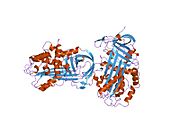플라스미노겐활성화억제제-1
Plasminogen activator inhibitor-1플라스미노겐활성화억제제-1(PAI-1)은 내피 플라스미노겐활성화억제제 또는 세르핀E1이라고도 하며, SERPINE1 유전자에 의해 인체 내에서 암호화되는 단백질이다.PAI-1의 증가는 혈전증 및 아테롬성[5] 동맥경화의 위험인자입니다
PAI-1은 세린단백질가수분해효소억제제(serpin)로 조직플라스미노겐활성화제(tPA)와 우로키나아제(uPA)의 주요 억제제로서 기능하며, 플라스미노겐활성화제(plasminogen)와 이에 따른 섬유화분해제(혈전의 생리학적 분해)의 활성제이다.세린단백질억제제(serpin)단백질(SERPINE1)이다.
다른 PAI인 플라스미노겐 활성화 억제제-2(PAI-2)는 태반에서 분비되며 임신 중에만 유의하게 존재한다.또한 단백질분해효소 넥신은 tPA 및 우로키나아제의 억제제로서 작용한다.그러나 PAI-1은 플라스미노겐 활성제의 주요 억제제이다.
유전학
PAI-1 유전자는 7번 염색체(7q21.3-q22)에 위치한 SERPINE1이다.프로모터 영역에는 4G/5G로 알려진 일반적인 다형성이 있습니다.5G 대립 유전자는 4G보다 전사 활성도가 약간 낮습니다.
기능.
PAI-1의 주요 기능은 플라스미노겐을 분해하여 플라스민을 형성하는 효소인 우로키나아제 플라스미노겐 활성제(uPA)의 억제를 수반한다.플라스민은 그 자체 또는 매트릭스 금속단백질가수분해효소와 함께 세포외 기질의 분해를 매개한다.이 시나리오에서는 PAI-1은 활성 사이트 바인딩을 통해 uPA를 억제하여 플라스민의 형성을 방지합니다.추가 억제는 uPA/u에 대한 PAI-1 결합에 의해 매개된다.PA 수용체 복합체로 인해 후자의 [6]분해가 발생합니다.따라서 PAI는 세린단백질가수분해효소 tPA 및 uPA/urokinase를 억제한다고 할 수 있으며, 따라서 혈전을 분해하는 생리학적 과정인 섬유소 분해의 억제제이다.또한 PAI-1은 기저층을 통한 악성세포 침입에 중요한 역할을 하는 매트릭스 금속단백질가수분해효소의 활성을 억제한다.
PAI-1은 주로 내피(혈관 안쪽에 있는 세포)에서 생성되지만 지방 조직과 같은 다른 조직 유형에서도 분비됩니다.
질병에서의 역할
선천성 PAI-1 결핍이 보고되었으며, 섬유소 분해가 적절하게 억제되지 않아 출혈성 치질(출혈 경향)로 이어진다.
PAI-1은 비만과 대사증후군뿐만 아니라 다양한 질병 상태(예: 다양한 형태의 암)에서 증가된 수치로 존재한다.그것은 이러한 질환이 있는 환자들의 혈전증 발생 증가와 관련이 있다.
PAI-1은 세포 [7]노화를 유도할 수 있다.PAI-1은 노화 관련 분비 표현형(SASP)[8]의 구성 요소일 수도 있다.
섬유소가 조직에 축적되는 염증 조건에서 PAI-1은 섬유증(결합조직의 병리학적 형성)으로의 진행에 중요한 역할을 하는 것으로 보인다.아마도 PAI 수치가 낮을수록 섬유소 분해 억제 효과가 떨어지고 반대로 섬유소의 분해 속도가 빨라질 것이다.
앤지오텐신II는 플라스미노겐활성화억제제-1의 합성을 증가시키기 때문에 아테롬성 동맥경화의 진행을 촉진한다.
약리학
- Tiplaxtinin(PAI-039)은 동맥 고혈압과 레닌-안지오텐신 [9]시스템의 활성화의 결과로 혈관의 리모델링 감쇠에 사용하기 위해 연구되고 있는 작은 분자 억제제이다.
- Annonacinone은 Annonaceae과 [10]식물에서 발견되는 자연적으로 발생하는 PAI-1 억제제이다.
상호 작용
플라스미노겐 활성제 억제제-1은 ORM1과 [11]상호작용하는 것으로 나타났다.
레퍼런스
- ^ a b c GRCh38: 앙상블 릴리즈 89: ENSG00000106366 - 앙상블, 2017년 5월
- ^ a b c GRCm38: 앙상블 릴리즈 89: ENSMUSG000037411 - 앙상블, 2017년 5월
- ^ "Human PubMed Reference:". National Center for Biotechnology Information, U.S. National Library of Medicine.
- ^ "Mouse PubMed Reference:". National Center for Biotechnology Information, U.S. National Library of Medicine.
- ^ Vaughan DE (August 2005). "PAI-1 and atherothrombosis". Journal of Thrombosis and Haemostasis. 3 (8): 1879–83. doi:10.1111/j.1538-7836.2005.01420.x. PMID 16102055. S2CID 6651339.
- ^ Carter JC, Church FC (2009). "Obesity and breast cancer: the roles of peroxisome proliferator-activated receptor-γ and plasminogen activator inhibitor-1". PPAR Research. 2009: 345320. doi:10.1155/2009/345320. PMC 2723729. PMID 19672469.
- ^ Zhang M, Serna-Salas S, Moshage H (2021). "Hepatic stellate cell senescence in liver fibrosis: Characteristics, mechanisms and perspectives". Mechanisms of Ageing and Development. 199: 111572. doi:10.1016/j.mad.2021.111572. PMID 34536446.
- ^ Valentijn FA, Falke LL, Nguyen TQ, Goldschmeding R (2018). "Cellular senescence in the aging and diseased kidney". Journal of Cell Communication and Signaling. 12 (1): 69–82. doi:10.1007/s12079-017-0434-2. PMC 5842195. PMID 29260442.
- ^ Elokdah H, Abou-Gharbia M, Hennan JK, McFarlane G, Mugford CP, Krishnamurthy G, Crandall DL (July 2004). "Tiplaxtinin, a novel, orally efficacious inhibitor of plasminogen activator inhibitor-1: design, synthesis, and preclinical characterization". Journal of Medicinal Chemistry. 47 (14): 3491–4. CiteSeerX 10.1.1.661.4972. doi:10.1021/jm049766q. PMID 15214776.
- ^ Pautus S, Alami M, Adam F, Bernadat G, Lawrence DA, De Carvalho A, Ferry G, Rupin A, Hamze A, Champy P, Bonneau N, Gloanec P, Peglion JL, Brion JD, Bianchini EP, Borgel D (2016). "Characterization of the Annonaceous acetogenin, annonacinone, a natural product inhibitor of plasminogen activator inhibitor-1". Scientific Reports. 6: 36462. doi:10.1038/srep36462. PMC 5120274. PMID 27876785.
- ^ Boncela J, Papiewska I, Fijalkowska I, Walkowiak B, Cierniewski CS (September 2001). "Acute phase protein alpha 1-acid glycoprotein interacts with plasminogen activator inhibitor type 1 and stabilizes its inhibitory activity". The Journal of Biological Chemistry. 276 (38): 35305–11. doi:10.1074/jbc.M104028200. PMID 11418606.
추가 정보
- Mimuro J (May 1991). "[Type 1 plasminogen activator inhibitor: its role in biological reactions]". [Rinshō Ketsueki] the Japanese Journal of Clinical Hematology. 32 (5): 487–9. PMID 1870265.
- Binder BR, Christ G, Gruber F, Grubic N, Hufnagl P, Krebs M, Mihaly J, Prager GW (April 2002). "Plasminogen activator inhibitor 1: physiological and pathophysiological roles". News in Physiological Sciences. 17: 56–61. PMID 11909993.
- Eddy AA (August 2002). "Plasminogen activator inhibitor-1 and the kidney". American Journal of Physiology. Renal Physiology. 283 (2): F209–20. doi:10.1152/ajprenal.00032.2002. PMID 12110504.
- Wang J, Li J, Liu Q (August 2005). "Association between platelet activation and fibrinolysis in acute stroke patients". Neurosci. Lett. 384 (3): 305–9. doi:10.1016/j.neulet.2005.04.090. PMID 15916851. S2CID 22979258.
- Schroeck F, Arroyo de Prada N, Sperl S, Schmitt M, Viktor M (2003). "Interaction of plasminogen activator inhibitor type-1 (PAI-1) with vitronectin (Vn): mapping the binding sites on PAI-1 and Vn". Biological Chemistry. 383 (7–8): 1143–9. doi:10.1515/BC.2002.125. PMID 12437099. S2CID 37813055.
- Gils A, Declerck PJ (March 2004). "The structural basis for the pathophysiological relevance of PAI-I in cardiovascular diseases and the development of potential PAI-I inhibitors". Thrombosis and Haemostasis. 91 (3): 425–37. doi:10.1160/TH03-12-0764. PMID 14983217.
- Durand MK, Bødker JS, Christensen A, Dupont DM, Hansen M, Jensen JK, Kjelgaard S, Mathiasen L, Pedersen KE, Skeldal S, Wind T, Andreasen PA (March 2004). "Plasminogen activator inhibitor-I and tumour growth, invasion, and metastasis". Thrombosis and Haemostasis. 91 (3): 438–49. doi:10.1160/TH03-12-0784. PMID 14983218.
- Harbeck N, Kates RE, Gauger K, Willems A, Kiechle M, Magdolen V, Schmitt M (March 2004). "Urokinase-type plasminogen activator (uPA) and its inhibitor PAI-I: novel tumor-derived factors with a high prognostic and predictive impact in breast cancer". Thrombosis and Haemostasis. 91 (3): 450–6. doi:10.1160/TH03-12-0798. PMID 14983219.
- Hertig A, Rondeau E (January 2004). "Plasminogen activator inhibitor type 1: the two faces of the same coin". Current Opinion in Nephrology and Hypertension. 13 (1): 39–44. doi:10.1097/00041552-200401000-00006. PMID 15090858. S2CID 30785986.
- Hoekstra T, Geleijnse JM, Schouten EG, Kluft C (May 2004). "Plasminogen activator inhibitor-type 1: its plasma determinants and relation with cardiovascular risk". Thrombosis and Haemostasis. 91 (5): 861–72. doi:10.1160/TH03-08-0546. PMID 15116245.
- Lijnen HR (January 2005). "Pleiotropic functions of plasminogen activator inhibitor-1". Journal of Thrombosis and Haemostasis. 3 (1): 35–45. doi:10.1111/j.1538-7836.2004.00827.x. PMID 15634264. S2CID 37085650.
- De Taeye B, Smith LH, Vaughan DE (April 2005). "Plasminogen activator inhibitor-1: a common denominator in obesity, diabetes and cardiovascular disease". Current Opinion in Pharmacology. 5 (2): 149–54. doi:10.1016/j.coph.2005.01.007. PMID 15780823.
- Dellas C, Loskutoff DJ (April 2005). "Historical analysis of PAI-1 from its discovery to its potential role in cell motility and disease". Thrombosis and Haemostasis. 93 (4): 631–40. doi:10.1160/TH05-01-0033. PMID 15841306.
- Könsgen D, Mustea A, Lichtenegger W, Sehouli J (June 2005). "[Role of PAI-1 in gynaecological malignancies]". Zentralblatt für Gynäkologie. 127 (3): 125–31. doi:10.1055/s-2005-836407. PMID 15915389.
- Hermans PW, Hazelzet JA (November 2005). "Plasminogen activator inhibitor type 1 gene polymorphism and sepsis". Clinical Infectious Diseases. 41 Suppl 7: S453–8. doi:10.1086/431996. PMID 16237647.
- Alessi MC, Poggi M, Juhan-Vague I (June 2007). "Plasminogen activator inhibitor-1, adipose tissue and insulin resistance". Current Opinion in Lipidology. 18 (3): 240–5. doi:10.1097/MOL.0b013e32814e6d29. PMID 17495595. S2CID 27667588.
외부 링크
- 펩티드가수분해효소 및 그 억제제에 대한 MEROPS 온라인 데이터베이스: I04.020
- 플라스미노겐+액티베이터+미국 국립 의학 도서관 의학 주제 제목(MeSH)의 억제제+1
- PDB의 UniProt: P05121(플라스미노겐 활성제 억제제 1)에서 PDBe-KB에 제공되는 모든 구조 정보의 개요.



















